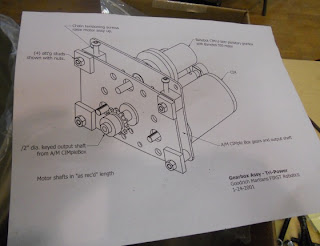Constructing the bottom of the robot frame was the focus of one of several build teams tonight.
Rivets holes were measured, drilled and popped into place with a pneumatic rivet tool.

A center punch is usually used to make an indentation in the metal, but a scratch awl works just as well to make the divots that enable accurate drilling of attachment holes in the frame! :-)
A second build team continued to work on the electrical and controls layout in a plywood mockup. This simulates the packaging space in the aluminum frame and allows simultaneous fabrication and construction under the direction of talented electrical mentors.
The multiple aluminum supports for the turret that will be mounted to the frame were also cut on a bandsaw and drilled with one of several drill presses in the build room.
Many of these supports have angled sides that were a bit difficult to cut.
Several of our team members also helped out making the Martian Team Buttons that are customarily given away at competitions as souveniers and traded with other teams for trinkets and collectibles.

Finally, and perhaps of top importance, students began to practice navigation techniques for driving the robot, using the XBox Kinect system. We intend to ultimately attach it to the robot vision system so navigating will simulate human anatomical movements of the driver.
It may be prohibited this year in competition, but it will evolve and we want to be ready!
















































